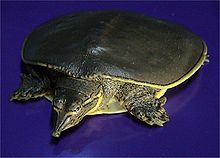Trionychia
Appearance
| Trionychia Temporal range:Late Jurassicto recent,
| |
|---|---|

| |
| Thespiny softshell turtle(Trionychidae) | |

| |
| Thepig-nosed turtle(Carettochelyidae) | |
| Scientific classification | |
| Domain: | Eukaryota |
| Kingdom: | Animalia |
| Phylum: | Chordata |
| Class: | Reptilia |
| Order: | Testudines |
| Suborder: | Cryptodira |
| Clade: | Polycryptodira |
| Superfamily: | Trionychia Hummel, 1929[1] |
| Families | |
|
Carettochelyidae | |
| Synonyms | |
| |
Trionychiais asuperfamilyofturtleswhich encompasses thespeciesthat are commonly referred to as softshelled turtles as well as some others. The group contains two families,Carettochelyidae,which has only one living species, thepig-nosed turtle(Carettochelys insculpta) native to New Guinea and Northern Australia, andTrionychidae,the softshelled turtles, containing numerous species native to Asia, North America and Africa. These families likely diverged during the late Jurassic.[2]The oldest known stem-trionychian isSinaspideretesfrom the Late Jurassic of China.[3][4]
Systematics
[edit]Except for those not assigned to a family, only living genera are listed here.
- FamilyCarettochelyidae
- SubfamilyCarettochelyinae
- GenusCarettochelys
- SubfamilyCarettochelyinae
- Pan-Trionychidae
- FamilyPlastomenidae[5](fossil)
- FamilyTrionychidae
- SubfamilyCyclanorbinae
- GenusCyclanorbis
- GenusCycloderma
- GenusLissemys
- SubfamilyTrionychinae
- GenusAmyda
- GenusApalone
- GenusChitra
- GenusDogania
- GenusNilssonia
- GenusPalea
- GenusPelochelys
- GenusPelodiscus
- GenusRafetus
- GenusTrionyx
- SubfamilyCyclanorbinae
References
[edit]- ^Rhodin 2011,p. 000.204
- ^Pereira, Anieli G.; Sterli, Juliana; Moreira, Filipe R.R.; Schrago, Carlos G. (August 2017)."Multilocus phylogeny and statistical biogeography clarify the evolutionary history of major lineages of turtles".Molecular Phylogenetics and Evolution.113:59–66.doi:10.1016/j.ympev.2017.05.008.hdl:11336/41137.ISSN1055-7903.PMID28501611.
- ^Ouyang, Hui; Li, Lu; Tong, Haiyan (July 2014). "A revision of Sinaspideretes wimani Young & Chow, 1953 (Testudines: Cryptodira: Trionychoidae) from the Jurassic of the Sichuan Basin, China".Geological Magazine.151(4): 600–610.Bibcode:2014GeoM..151..600T.doi:10.1017/S0016756813000575.ISSN0016-7568.S2CID128423062.
- ^Evers, Serjoscha W.; Benson, Roger B. J. (January 2019). Smith, Andrew (ed.)."A new phylogenetic hypothesis of turtles with implications for the timing and number of evolutionary transitions to marine lifestyles in the group".Palaeontology.62(1): 93–134.doi:10.1111/pala.12384.S2CID134736808.
- ^One or more basal lineages formerly believed to be a distinct family
- Bibliography
- Rhodin, Anders G.J.; van Dijk, Peter Paul; Inverson, John B.; Shaffer, H. Bradley; Roger, Bour (2011-12-31)."Turtles of the world, 2011 update: Annotated checklist of taxonomy, synonymy, distribution and conservation status"(PDF).Chelonian Research Monographs.5.Archived fromthe original(PDF)on 2012-01-31.
